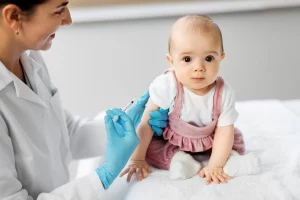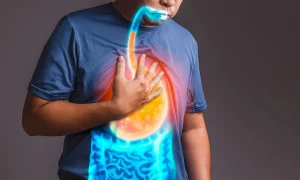For a young child with life-threatening food allergies “the world looks like a minefield,” a New Jersey mother says.
It’s a stress-filled landscape that financial adviser Amy Leis knows all too well. Her daughter Zoe was just a few months old when she suffered her first serious reaction to food, a potentially deadly event known as anaphylactic shock.
“I was terrified,” Leis recalled. “I had been baking cupcakes, and I gave her a taste, and she started turning blue.”
In short order, Zoe was diagnosed with congenital allergies to a broad range of foods. Eggs, dairy, peanuts and tree nuts were pegged as potentially lethal. Soy, wheat, seafood and shellfish were all deemed no-nos.
Ever since, the stakes couldn’t be higher. So like millions of American “food allergy families,” Leis and her family embraced a life of 24/7 vigilance, avoidance and well-founded fear.
It’s a recipe, experts say, for the sort of overwhelming anxiety that can leave families feeling paralyzed and trapped.
But a new pediatric treatment program has shown promise as a way to help reign in anxiety and fear among food allergy patients and their parents alike.
The Food Allergy Bravery program is a first-of-its-kind behavioral therapy effort launched in 2018 under the auspices of Children’s Hospital of Philadelphia (CHOP).
“Anxiety around food allergy can be incredibly challenging,” noted pediatric nurse practitioner Megan Lewis, a program manager in the Division of Allergy and Immunology at CHOP’s Food Allergy Center.
“Families and patients with food allergy often rate their quality of life worse than those with chronic diseases like diabetes and childhood cancers,” Lewis noted. “Food is everywhere and a part of almost every social situation. Navigating it safely can be incredibly stressful for families.”
To tackle the issue, Lewis and her colleagues devised a program centered on five to eight sessions of cognitive behavioral therapy (CBT). Each lasts 30 to 45 minutes. During that time kids from 6 to 18 years of age are slowly encouraged to face their food-related fears head on through a series of carefully supervised “bravery challenges.”
A form of exposure therapy, the challenges might involve briefly touching or sniffing a problematic food, or being encouraged to embrace non-problematic foods without unwarranted fear. The challenges are also designed to be repeated at home. The aim is to boost children’s confidence and sense of control without putting them in jeopardy.
At the same time, parents and kids are taught what truly constitutes safe — or “safe enough” — so everyone can better distinguish between real risk and manageable risk.
A new study published in Annals of Allergy, Asthma & Immunology suggests the program delivers.
After 10 kids (ages 8 to 12) and their parents completed a six-session regimen, both general anxiety and food-related anxiety declined sharply among the kids, Lewis and her team reported. Post-treatment, both parents and children had notable improvements in quality of life, and all the parents said the program was “very” or “extremely” helpful.
An outside expert who reviewed the findings said using cognitive behavioral therapy to address food allergy trauma is “very exciting.”
“CBT is a mode of treatment that really provides the individual with a strong sense of their ability to manage issues, their ability to see problems, assess them to determine how to manage them, and then the ability to learn new techniques,” said Connie Diekman. She’s a St. Louis-based food and nutrition consultant, and former president of the Academy of Nutrition and Dietetics.
“Given the strong benefits of CBT, it is not surprising that it did help these children, and their families, reduce their anxiety about their safety as they deal with a food allergy,” Diekman added.
Probably nobody is more excited by the results than Leis.
While still a toddler, Zoe began “oral immunotherapy” treatment, essentially a life-long habit that aims to build up a protective amount of allergy tolerance by regularly exposing patients to very small amounts of problem foods.
“We wanted her to be ‘bite safe,’ meaning if she accidentally has a bite of this food she probably won’t die,” Leis said. “And it helped her. It took years and years, but it really helped.”
Even so, the family was always on high alert, she added.
“It was awful,” Leis recalled. “Never letting your guard down. And by the time Zoe was right around 7 she started having panic attacks.”
Then and there, Zoe was enrolled in the CHOPS program. And the change, Leis said, was evident within a couple of weeks.
“Just imagine a kid who every day used to eat lunch all by herself at school,” she said. “A child who had never been to a birthday party by herself. Never been at a sleepover. I don’t think she realized at the time how anxious she had become.”
But, Leis said, this program gave the family an “enormous gift.”
“We learned what was possible — what we could do safely, how to do things safely,” she said. “It was real-world. It was practical. And it taught us as a family how to make calculated risks, and how to be brave and really live our lives, and how to empower our kid when it comes to handling food allergies.”
Now 11, Zoe has blossomed, her mother said.
“She’s become this confident young person,” Leis said. “And it’s let all of us interact with her in the world in a way we never ever imagined. That program was life-changing. Life-changing for our whole family.”
More information
Children’s Hospital of Philadelphia has more about kids and food allergies.
SOURCES: Megan Lewis, MSN, CRNP, RN, pediatric nurse practitioner, and program manager, Food Allergy Center, Children’s Hospital of Philadelphia; Connie Diekman, MEd, RD, CSSD, LD, food and nutrition consultant, St. Louis, and former president, Academy of Nutrition and Dietetics; Amy Leis, PhD, New Jersey, parent of pediatric food allergy patient; Annals of Allergy, Asthma & Immunology, Sept. 23, 2022
Source: HealthDay
Copyright © 2025 HealthDay. All rights reserved.

















